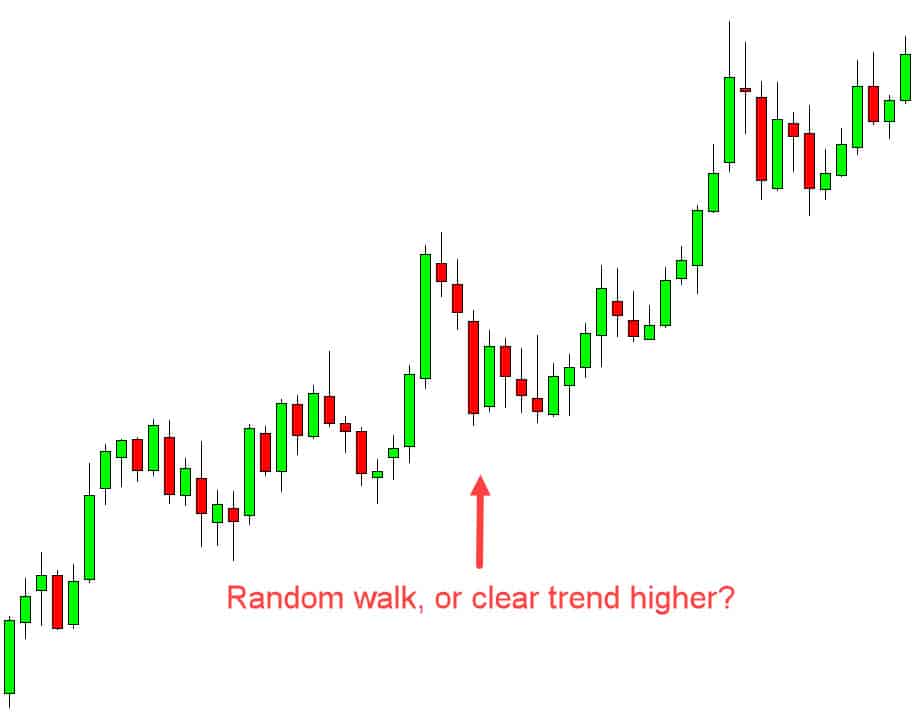The random walk theory is a theory that has been debated for many years.
Understanding how the random walk theory works can help you find better trading strategies in your trading.
This post goes through exactly what the random walk theory is and how you can use it in your trading.
NOTE: You can get your random walk theory trading guide below.
What is the Random Walk Theory
While the random walk theory has been debated in trading circles for many years now, it can be traced back to Jules Regnault, who published his thoughts in an 1863 book.
Since then, there have been more testing and thoughts on the matter from Louis Bachelier, who published a dissertation on the theory of speculation, through to Paul Cootner, who in 1964 wrote a book titled ‘The random character of stock market prices.’
The term “random walk” was made popular by Burton Malkiel, a professor at Princeton University who wrote a book in 1973 titled “A random walk down Wall Street.”
The theory is that all prices in the markets move randomly and that there are no logical trends that traders can use. We are about to look at if the random walk theory is accurate or if there are trends and market psychology that are repeatable over time.
Random Walk Theory and Efficient Market Hypothesis
Burton Malkiel, the man who wrote “A random walk down Wall Street,” carried out a random walk test.
This test consisted of Malkiel giving his student a hypothetical stock. The students would flip a coin, and if the coin showed heads, the stock price would increase by half a point. If it flipped tails, then the stock would move lower by half a point.
Malkiel attempted to see if cycles or trends could be found from this test.
After concluding the coin flipping, Malkiel took the results of the stock price movement using a coin to a technical analyst.
The technical analysis told Malkiel that he should buy the stock based on the chart he could see from the stock price movement. Since this was a hypothetical test flipping coins to establish if the price went higher or lower, there was no trend or cycle as each coin flip was a 50/50 of landing heads or tails.
Malkiel concluded that stock price movements were just as random as flipping coins.
Another to carry out extensive tests were professors Andrew Lo and Archie MacKinlay. These two, however, believe in the opposite and that there are clear trends and cycles that markets move through and that traders can predict. They also believe that markets can be predictable to a certain degree.
Using the Random Walk Theory in Finance
People that believe in the random walk theory are much more likely to advise investing in an index fund or a basket of stocks.
Because throughout history, stock markets have risen over time, even after different stock market crashes, people who believe in the random walk see it as better to invest over the long term.
Random walk traders are much more likely to believe that picking certain stocks over another and trying to predict smaller movements is unpredictable and unreliable. They believe this because they take the view that the markets don’t have predictable price trends or cycles.
This, however, is up for debate.
For 14 years, the Wall Street Journal ran a test where professional stock pickers competed against stocks picked by throwing random darts at different stocks to make selections.
After 14 years, there was no conclusion either way about whether the market is random or moves in trends and cycles.
In recent years it is becoming more likely that there are trends and cycles that traders can take advantage of with their trades. Computer systems and bots are using these trends to make trades, even if these trades only last for a tiny amount of time. With these bots being so predictable, it is more likely that trends and cycles can be predictable and that the markets are not entirely random.
How to Use the Random Walk Theory for Your Trading
If you believe in the random walk theory and that the markets move at random, you would be better off looking to invest in managed or index funds.
Over many years and even taking into account different market crashes, these funds have been positive overall. Taking this longer-term approach takes out the risks of predicting and timing the markets.
If you believe that there are trends and cycles that prices go through, you would be better off looking at strategies such as technical analysis and chart patterns.
Technical analysis and chart pattern traders believe that the market does move in cycles. They also think that the markets tend to repeat themselves through trader psychology.
The reason trading chart patterns is so popular with today’s traders is that these traders believe that different patterns show the psychology behind the recent market movements. They also believe this can be used to predict where the price will move next to make profitable trades.
Random Walk Theory Examples
While we have looked at those who believe in the random walk theory, but there are also a lot of others who believe that the markets move in patterns and that, to some degree, markets can be predictable.
One of these people is Martin Weber, who is a leading researcher in the behavioral finance space. He believes the markets are a “Non-random walk.”
Weber undertook a study where he looked at the price of stocks over ten years.
He looked to identify different trends and cycles and if the markets were predictable to any degree through this period.
What he found was that the markets are often predictable. His research also found that stocks that had a significant increase in the first five years of the study then often become underperformers over the next five years. This showed that the markets could be predictable with specific strategies.
Lastly
While the random walk theory has been debated for decades now, in more recent times, traders and researchers are starting to show the markets can be predicted to a degree.
Through tests and research, these traders are starting to show that different strategies can be used to trade the markets profitably.
In recent years many trading algorithms and bots are making a profit by predicting the markets. While these trades by trading computers often last a fraction of a second, it shows that the markets can be predicted and traded profitably using their different cycles and structure.
NOTE: You can get your random walk theory trading guide below.
Stock Markets Guides content team.

